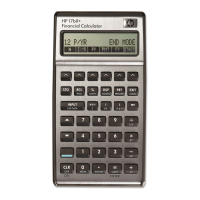2: Arithmetic 47
File name : English-M02-1-040308(Print).doc Print data : 2004/3/9
You can also do arithmetic with the values stored in variables. For
example, 2
s*
(in the MU%C menu) multiplies the current
contents of M%C by 2 and stores the product in M%C.
Scientific Notation
Scientific notation is useful when working with very large or very small
numbers. Scientific notation shows a small number (less than 10) times
10 raised to a power. For example, the 1984 Gross National Product of
the United States was $3,662,800,000,000. In scientific notation, this is
3.6628 x10
12
. For very small numbers the decimal point is moved to the
right and 10 is raised to a negative power. For example, 0.00000752
can be written as 7.52 x 10
−
6
.
When a calculation produces a result with more than 12 digits, the
number is automatically displayed in scientific notation, using a capital
E in place of “x10^”.
Remember that
&
changes the sign of the entire number, and not of
the exponent. Use
-
to make a negative exponent.
Type in the numbers 4.78 x 10
13
and −2.36 x 10
−
15
.
Keys: Display: Description:
4.78
@\
13
Pressing
@\
starts the
exponent.
@c
Clears number.
2.36
@\-
15
Pressing
-
before an
exponent makes it
negative.
&
Pressing
&
makes the
entire number negative.
@c
Clears number.

